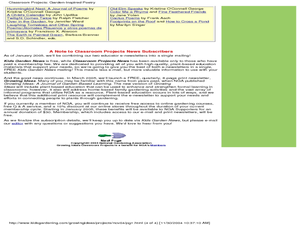Paul Hudson
SPQR Latin Dictionary and Reader
Searching for an incredibly thorough Latin app? Look no further! Latin learners will be quite satisfied with the collection of texts, three dictionaries, customizable flashcards, assessment options, and other features that are right at...
Curated OER
Nurture Poetry
Learners create a poetry book. In this poetry lesson, students write a cinquain poem, name poem, haiku, limerick, and preposition poem.
Poetry4kids
How to Write Funny Poetry — Chapter 2: How to Rhyme
Funny poems don't have to rhyme—but it helps! Learn how to use rhyming words to add humor to funny, clever, or just plain silly poems.
Poetry4kids
How to Write Funny Poetry — Chapter 1: Writing Poetry
Do you wish you could write poetry that makes people laugh? Now you can! Check out the first chapter in a poetry writing series that emphasizes the importance of connecting subject matter to a light, bouncy meter.
Macmillan Education
Understanding Poetry (Elementary)
Introduce young readers to poetry analysis with a learning exercise that uses Emily Bronte's "Spellbound" to model how poets use word choice, the sounds of words, the repetition of words, and rhyming patterns to create the mood, tone,...
Poetry4kids
Rhythm in Poetry: Okie Dokie, Here’s the Trochee
Iambs and trochees may seem intimidating to some learners, but after reading a straightforward online lesson, they'll be masters of poetic feet! The lesson includes examples of trochaic poems from Edgar Allen Poe and William Blake.
Poetry4kids
Rhythm in Poetry: More Than Two Feet
Want to put some feet in your head? Check out an online lesson about spondees, dactyls, and anapests to bring new structure to your poetic forms.
Tiny Mobile
Poetry Creator | Verses
Construct from a canvas of words, lyrical expressions that your budding poets can share and post. Based on refrigerator magnet poetry, creative writers can develop their poetry independently, or from a given prompt from their instructor.
Curated OER
Poetry: "The Poplar Field" by William Cowper
Explore poetry analysis. Learners read the poem "The Poplar Field" by William Cowper, answer a series of questions, and discuss literary devices. It is a terrific way to help your class understand how to read and understand poetry.
Poetry4kids
Simile and Metaphor Lesson Plan
Similes and metaphors are the focus of a poetry lesson complete with two exercises. Scholars read poetry excerpts, underline comparative phrases, then identify whether it contains a simile or metaphor. They then write five similes and...
Curated OER
Christmas Tree Shaped Poems
Learners think about ways in which they can spread joy during the holiday season. They create poems in the shape of a Christmas tree. Pupils use formatting tools in Microsoft Word to format the text of the poem. Students discuss ways...
Curated OER
Growing Poems
Students write garden inspired poetry. In this poetry lesson plan, students go out into the garden and write poems about how they feel, what they see, and what is going on in the garden.
National Endowment for the Humanities
The Beauty of Anglo-Saxon Poetry: A Prelude to Beowulf
Riddle me this! What do kennings, caesura, and alliteration have to do with the Nowell Codex? Introduce class members to Anglo-Saxon poetry and prepare readers for a study of Beowulf with a series of activities that includes asking...
Poetry Society
Imaginary Words
Oh, what fun! Young logophiles and neologists create a dictionary-sounding definition for imaginary words and try to fool their classmates.
Poetry4kids
Alliteration and Assonance Lesson Plan
Scholars analyze the poem My Puppy Punched Me in the Eye by Ken Nesbitt in order to locate examples of alliteration and assonance. After reading the poem, alliterative words are underlined and assonant words are circled.
Curated OER
Camels Theme Unit
In this Camel themed worksheet, learners create an alliteration, an acrostic poem, and work with similes. The unit consist of three pages of language arts work, based on Camels.
Curated OER
Louisiana's Tragic Hero - "Evangeline"
"Ye who believe...List to a Tale of Love in Acadie." Longfellow's epic poem, "Evangeline," launches a study of tragic heroines, epic poetry, the expulsion of the Acadians from Canada, and their subsequent migration to Louisiana. The...
Curated OER
Elements of Poetry
Prepare your learners to identify figurative language in poetry. Tips for reading poetry and what to look for are listed on these slides. Rhetorical devices are defined and plenty of examples are given.
Curated OER
I Spy Poetry
Explore the components of rhythm and form through a reading of Jean Marzollo's I Spy books. After discussing Marzollo’s format, the class agrees upon a theme for a class book and topics that fit with that theme. Pupils write a poem,...
abcteach
Dragon Alliterations
You don't have to slay the dragon in this activity. Young writers review poetic devices with a set of worksheets about alliteration and similes. Once they finish waxing poetic about their dragon friends, they craft a final acrostic poem.
Harper Collins
The Giving Tree Anniversary Teaching Guide
Celebrate poetry month all of April with a guide that uses six of Shel Silverstein's most famous books as a basis for the lessons. Discussion questions and writing activities are provided for each of Silverstein's books.
Curated OER
Acrostic Poems: What's In a Name?
Learners find words that begin with the letters in their own names, using a variety of sources including word banks and online dictionaries. They create an acrostic poem. Pupils revise poems as needed, for meaning and conventions. ...
Curated OER
Poetry Power
Second graders explore language arts by analyzing poems in their class. In this word play lesson, 2nd graders define the terms rhyme, rhythm and alliteration and identify their uses. Students utilize class word lists to write their own...
Curated OER
Poetry in Motion
High schoolers explore poetry and technology. In this poetry writing lesson, students choose a theme and write a pattern poem, then create a related slideshow.

























